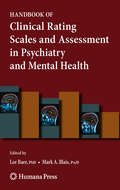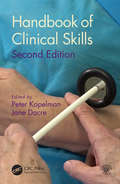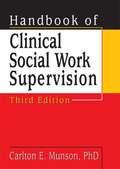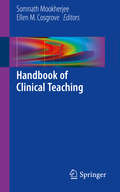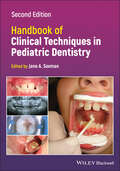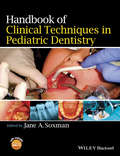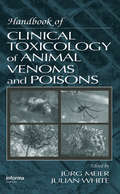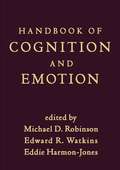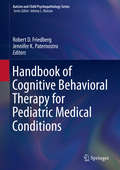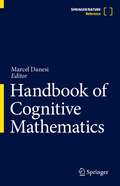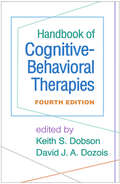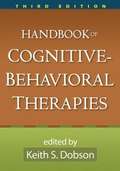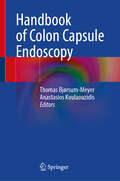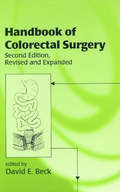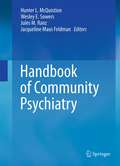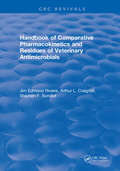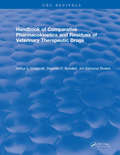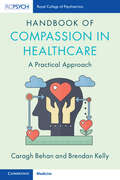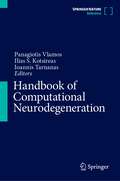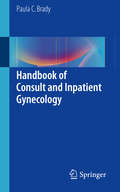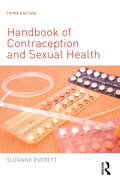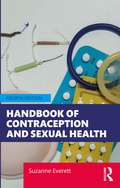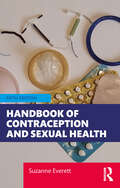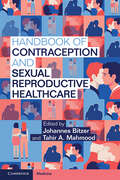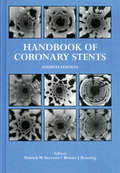- Table View
- List View
Handbook of Clinical Rating Scales and Assessment in Psychiatry and Mental Health
by Lee Baer Mark A. BlaisPsychiatric clinicians should use rating scales and questionnaires often, for they not only facilitate targeted diagnoses and treatment; they also facilitate links to empirical literature and systematize the entire process of management. Clinically oriented and highly practical, the Handbook of Clinical Rating Scales and Assessment in Psychiatry and Mental Health is an ideal tool for the busy psychiatrist, clinical psychologist, family physician, or social worker. In this ground-breaking text, leading researchers provide reviews of the most commonly used outcome and screening measures for the major psychiatric diagnoses and treatment scenarios. The full range of psychiatric disorders are covered in brief but thorough chapters, each of which provides a concise review of measurement issues related to the relevant condition, along with recommendations on which dimensions to measure - and when. The Handbook also includes ready-to-photocopy versions of the most popular, valid, and reliable scales and checklists, along with scoring keys and links to websites containing on-line versions. Moreover, the Handbook describes well known, structured, diagnostic interviews and the specialized training requirements for each. It also includes details of popular psychological tests (such as neuropsychological, personality, and projective tests), along with practical guidelines on when to request psychological testing, how to discuss the case with the assessment consultant and how to integrate information from the final testing report into treatment. Focused and immensely useful, the Handbook of Clinical Rating Scales and Assessment in Psychiatry and Mental Health is an invaluable resource for all clinicians who care for patients with psychiatric disorders.
Handbook of Clinical Skills: Second Edition
by Peter Kopelman Dame Jane Dacre" ... well-structured with good "bullet" points, diagrams, and quality coloured pictures making it most easy to read. Overall, I considered this little gem a worthwhile possession for all trainees" - Postgraduate Medicine JournalFirst published in 2002, this popular handbook focuses on the practical application of clinical skills aimed specifically at medical students and doctors in training. This much-anticipated second edition remains readable, concise and pocket-sized, while being extensively updated to reflect the latest learning requirements. Existing chapters, including an overview of the general examination followed by chapters on examination specific to each body system, child health and mental health, are supplemented by the general practice consultation and a new chapter that brings the specialist clinical methods of previous chapters together and considers their application within and abbreviated timescale.Key features:• New edition of well-established and highly respected handbook focused on the needs of medical students and junior doctors• Reflects the expansion of the traditional skills of history taking and clinical examination, whilst ensuring complete familiarity with and understanding of the ‘basics’• Places the patient at the centre of care recognising that good, compassionate communication with patients and their relatives contributes to satisfactory clinical outcomes• Video clips provide additional, illustrative guidance to good procedural practice – visit https://www.crcpress.com/cw/kopelmanThe second edition of this classic handbook continues to provide brief, readable chapters on important skills, enhanced by supplementary videos to demonstrate how they can be mastered and how they may be applied.
Handbook of Clinical Social Work Supervision
by Carlton MunsonTake social work supervision into the new millennium!This newly revised edition of the classic text is a thorough, comprehensive guidebook to every aspect of supervision, including learning styles, teaching techniques, emotional support for supervisors, and supervision in different settings. Its detailed discussions of ethics and legal issues in practice are invaluable. Designed for use by busy supervisors, Handbook of Clinical Social Work Supervision, Third Edition, offers a new partnership model of supervision.Thoroughly revised and updated, Handbook of Clinical Social Work Supervision, Third Edition, addresses the dramatic changes in the field brought by new technologies and managed care. Numerous case illustrations and exercises supplement the text to facilitate classroom discussion or continuing education seminars. Assessment scales have been modified to conform to more recent data, and the questionnaires have been extensively revised. In addition, you will find significant new material on crucial topics, including: using DSM-IV categories for diagnosis and assessment how managed care has changed treatment planning, practice protocols, documentation, and other aspects of social work issues of cultural diversity, including respect for persons with disabilities and handling gender issues dealing with specific problems and populations, including domestic violence, substance and alcohol abuse, and child and adolescent treatment a model for managing organizational change social worker stress and burnout new directions for social work as a professionHandbook of Clinical Social Work Supervision, Third Edition, will help you change your practice with the times by incorporating the capabilities of the Internet and other advanced technologies. It will also teach you to work around the restrictions created by managed care insurance plans. This bestselling textbook is ideal for classroom use as well as being an essential resource for any supervisor.
Handbook of Clinical Teaching
by Somnath Mookherjee Ellen M. CosgroveTargeting the practical needs ofclinical teachers who do not have extensive time to undergo additionaltraining, this book provides an accessible, on-the-spot resource to bolsterteaching skills and optimize the education of trainees. A massivetransformation takes place every summer in the United States: thousands oftrainees in graduate medical education are appointed as attending physiciansresponsible for effectively teaching the next generation of medical studentsand residents. This handbook includes only the most relevant topics for newclinical teachers, and covers the basics of clinical teaching, teaching inspecific situations, teaching different audiences, and best practices forhandling challenging situations. The format is conducive to "just in time"learning, perfect for quick reference before meeting with learners or engagingin specific teaching situations, such as in an ambulatory clinic or at thebedside. Key points are emphasized with frequent use of tables and boxedpractical content. Applicable to all teaching attendings regardless ofspecialty, the Handbook of Clinical Teaching is a valuable aid for individualswho wish to improve their teaching, and serves as a practical guide for facultydevelopment in clinical teaching.
Handbook of Clinical Techniques in Pediatric Dentistry
by Jane A SoxmanThe Second Edition of the Handbook of Clinical Techniques in Pediatric Dentistry features updated and expanded information on pediatric clinical dentistry, including eight new chapters written by educators with special interest in each topic. Since publication of the first edition, non-invasive treatment is at the forefront of pediatric dental care, and the new edition reflects this, with multiple options and techniques for non-invasive treatment. The book is filled with photographs for improved understanding and guidance through the procedures described. The book is an easy-to-read guide to clinical pediatric dentistry with practical evidence-based information for dental students, assistants, hygienists, residents in both general dentistry and specialty training, and general and pediatric dentists. Handbook of Clinical Techniques in Pediatric Dentistry is a valuable resource for assuring excellence in care for our youngest patients. Key Features Presents step-by-step clinical instruction for pediatric procedures Features eight new chapters, including non-invasive clinical techniques, trauma to primary incisors, caries-risk assessment, oral pathology, interceptive orthodontics, esthetics, sleep disordered breathing, infant examination, and treating the special needs patient Offers more than 600 clinical and radiographic photographs Provides practical information and guidance for clinical practice in pediatrics
Handbook of Clinical Techniques in Pediatric Dentistry
by Jane A. SoxmanThe Handbook of Clinical Techniques in Pediatric Dentistry provides the clinician with an increased level of expertise and skills for timely identification and intervention for various presentations in the developing dentition. It also clearly describes procedures for treatment in the primary and young permanent dentitions, including pulp therapy for primary and young permanent molars, extractions, space maintenance, and more. The most commonly encountered treatment needs are discussed with the goal of increasing clinician and staff confidence while decreasing chair-time and stress.With an emphasis on practical instruction, The Handbook of Clinical Techniques in Pediatric Dentistry is ideal for pediatric and general dentists, pediatric residents, and dental students taking clinical pediatric courses.
Handbook of Clinical Toxicology of Animal Venoms and Poisons
by Julian White Jurg MeierThe Handbook of Clinical Toxicology of Animal Venoms is the first concise, one-volume book devoted to this important subject. The editors are internationally recognized authorities in the biology and clinical aspects of venomous and poisonous animals, and the chapter authors are world leaders in their respective fields of toxicology.All aspects of the topic are covered including information on the biology and taxonomy of poisonous animals, their venom or poison, diagnosis, and general treatment principles and specific treatment. The most up-to-date list of available antivenoms is provided. Coverage of venomous and poisonous animals is comprehensive, with thorough discussions on shellfish poisoning, ciguatera, fugu, coelenterates, stingrays, venous fish, blue-ringed octopus, sea-snakes, scorpions, spiders, insects, and gila lizards. Individual chapters focus on snakes and snakebite in Europe, Africa, Asia, Australia, North America, Central America, and South America. Nearly all clinical chapters have been written by clinicians with extensive experience treating the particular type of animal envenoming or poisoning under consideration.No other book brings together such a wealth of information in this field, and no other book provides it in a format useful to clinicians charged with the responsibility of treating envenomed or poisoned patients. The Handbook of Clinical Toxicology of Animal Venoms is an essential addition to all medical libraries, emergency departments, toxicology departments, poison information centers, and invaluable to all professionals working in these fields.
Handbook of Cognition and Emotion
by Eddie Harmon-Jones Edward R. Watkins Michael D. RobinsonComprehensively examining the relationship between cognition and emotion, this authoritative handbook brings together leading investigators from multiple psychological subdisciplines. Biological underpinnings of the cognition-emotion interface are reviewed, including the role of neurotransmitters and hormones. Contributors explore how key cognitive processes--such as attention, learning, and memory--shape emotional phenomena, and vice versa. Individual differences in areas where cognition and emotion interact--such as agreeableness and emotional intelligence--are addressed. The volume also analyzes the roles of cognition and emotion in anxiety, depression, borderline personality disorder, and other psychological disorders.
Handbook of Cognitive Behavioral Therapy for Pediatric Medical Conditions (Autism and Child Psychopathology Series)
by Robert D. Friedberg Jennifer K. PaternostroThis handbook offers a comprehensive review of cognitive behavioral therapy (CBT) for working in integrated pediatric behavioral health care settings. It provides research findings, explanations of theoretical concepts and principles, and descriptions of therapeutic procedures as well as case studies from across broad conceptual areas. Chapters discuss the value of integrated care, diversity issues, ethical considerations, and the necessary adaptations. In addition, chapters address specific types of pediatric conditions and patients, such as the implementation of CBT with patients with gastrointestinal complaints, enuresis, encopresis, cancer, headaches, epilepsy, sleep problems, diabetes, and asthma. The handbook concludes with important directions in research and practice, including training and financial considerations.Topics featured in this handbook include: Emotional regulation and pediatric behavioral health problems. Dialectical Behavior Therapy (DBT) for pediatric medical conditions. Pharmacological interventions and the combined use of CBT and medication. CBT in pediatric patients with chronic pain. CBT for pediatric obesity. CBT-informed treatments and approaches for transgender and gender expansive youth.Medical non-compliance and non-adherence associated with CBT.Training issues in pediatric psychology. The Handbook of Cognitive Behavioral Therapy for Pediatric Medical Conditions is an essential resource for researchers and graduate students as well as clinicians, related therapists, and professionals in clinical child and school psychology, pediatrics, social work, developmental psychology, behavioral therapy/rehabilitation, child and adolescent psychiatry, nursing, and special education.
Handbook of Cognitive Mathematics
by Marcel DanesiCognitive mathematics provides insights into how mathematics works inside the brain and how it is interconnected with other faculties through so-called blending and other associative processes. This handbook is the first large collection of various aspects of cognitive mathematics to be amassed into a single title, covering decades of connection between mathematics and other figurative processes as they manifest themselves in language, art, and even algorithms. It will be of use to anyone working in math cognition and education, with each section of the handbook edited by an international leader in that field.
Handbook of Cognitive-Behavioral Therapies, Fourth Edition
by Keith S. Dobson David J. DozoisNow revised and expanded with over 50% new material, this definitive clinical reference is the text of choice for graduate-level courses in evidence-based psychotherapy. Foremost authorities describe the conceptual and scientific foundations of cognitive-behavioral therapy (CBT) and provide a framework for assessment and case formulation. Major approaches are reviewed in detail, including emotion-centered problem-solving therapy, rational emotive behavior therapy, cognitive therapy, schema therapy, mindfulness- and acceptance-based interventions, and dialectical behavior therapy (DBT). Applications to specific populations are discussed, including children and adolescents, couples, culturally diverse clients, and more. New to This Edition *Chapter on clinical assessment. *Chapter on DBT. *Chapters on transdiagnostic treatments, CBT-based prevention models, and improving dissemination and implementation. *Existing chapters extensively revised or rewritten to reflect important research and clinical advances.
Handbook of Cognitive-Behavioral Therapies, Third Edition
by Keith DobsonThis acclaimed text and practitioner reference presents an authoritative overview of major models of cognitive-behavioral therapy (CBT). Foremost treatment developers explain core CBT principles and provide a framework for systematic assessment, case conceptualization, and treatment planning. Scholarly yet accessible chapters on each therapy detail what makes the approach unique, which clinical problems it is used to treat, what assessment and intervention tools have been developed, how they are implemented, and what the research reveals about the therapy's effectiveness. Special topics include working with children and adolescents, couples, and culturally diverse clients. The Handbook has been widely adopted in training programs, and the revisions in this edition reinforce its value as a text. New to This Edition The latest findings and clinical advances. Additional therapies schema therapy and mindfulness- and acceptance-based interventions. Chapter on the empirical evidence base for CBT.Chapters on treatment of couples and culturally diverse clients.
Handbook of Colon Capsule Endoscopy
by Thomas Bjørsum-Meyer Anastasios KoulaouzidisThis book is the first dedicated to the colon capsule endoscopy (CCE). It offers a a-state-of-the-art description of all aspects of the procedure, including performance in detecting colorectal lesions and other non-neoplastic pathology as developed over the last decade through extensive clinical research. The CCE is now viewed as a diagnostic test for the colorectum equal to conventional colonoscopy and computer tomography colonography (CTC). An increasing number of studies have shown challenges that need to be addressed to improve the adoption of CCE, including optimizing bowel preparations and pre-selection of patients to improve completion rates and lower re-investigation rates.All chapters are written by worldwide experts of CCE, and accompanied by illustrative pictures of the normal anatomy as depicted by CCE and pathological findings with a particular focus on neoplastic lesions. The volume is completed by videos of colon capsule endoscopies including normal anatomy, common colorectal lesions as viewed by camera capsules and common pitfalls. A test on essential issues and take-home messages are included in the final chapter. This handy volume is aimed at health care providers involved in CCE and researchers and medical students at all levels who need a thorough introduction to CCE and which gaps are striving for further research.
Handbook of Colorectal Surgery
by David E. BeckCompletely revised and expanded to include technological advances, the second edition of this text illustrates key anatomical structures, examination procedures and surgical techniques for proper diagnosis, management and treatment of patients with colorectal disorders, providing extensive coverage of various methods in preoperative preparation and
Handbook of Community Psychiatry
by Jacqueline Maus Feldman Hunter L. Mcquistion Wesley E. Sowers Jules M. RanzDuring the past decade or more, there has been a rapid evolution of mental health services and treatment technologies, shifting psychiatric epidemiology, changes in public behavioral health policy, and increased understanding in medicine regarding approaches to clinical work that focus on patient-centeredness. These contemporary issues need to be articulated in a comprehensive format. The American Association of Community Psychiatrists (AACP), a professional organization internationally recognized as holding the greatest concentration of expertise in the field, has launched a methodical process to create a competency certification in community psychiatry. As a reference for a certification examination, that effort will benefit enormously from a comprehensive handbook on the subject.
Handbook of Comparative Pharmacokinetics and Residues of Veterinary Antimicrobials
by Jim E RiviereThe major objective of this handbook is to compile-in tabular form-the pharmacokinetic parameters of antimicrobial drugs used in food animals. This unique publication represents data from the FARAD (Food Animal Residue Avoidance Databank) databank, established by the authors under the auspices of the U.S.D.A. and contains significant amounts of previously unavailable information. This updated, one-of-a-kind volume even features additional data on laboratory rodents, dogs, cats, and horses in order to facilitate broader interspecies extrapolations. This easy-to-use reference is timely as well as invaluable to animal scientists, veterinarians, pharmacologists, and toxicologists who work with antimicrobials in chickens, turkeys, dairy and beef cattle, swine, goats, and sheep.
Handbook of Comparative Pharmacokinetics and Residues of Veterinary Therapeutic Drugs
by Arthur L. CraigmillHandbook of Comparative Pharmacokinetics and Residues of Veterinary Therapeutic Drugs is a unique compilation of comparative pharmacokinetic data for veterinary therapeutic drugs. The book features an excellent introductory chapter on basic veterinary pharmacokinetics and includes pharmacological data taken from hundreds of primary research references. These data are presented in standardized units and are arranged in conveniently organized tables so that comparisons between data can be made easily. Much of the data is new and was taken from articles in which data was not subjected to pharmacokinetic analysis.
Handbook of Compassion in Healthcare: A Practical Approach
by Brendan Kelly Caragh BehanWhat is compassion? Although a fundamental value in healthcare, this concept is often misunderstood and difficult to navigate. The authors of this book aim to answer this fundamental question, as well as offer a practical approach to how to use it in medicine. Comprised of two parts, the first part of this book explores the background to compassionate healthcare, examines how it differs from other concepts and outlines its relationship to medical professionalism. The second part offers a practical guide full of strategies and exercises to assist healthcare workers in practicing compassion by cultivating mindfulness and awareness, deepening compassion in care. This book is essential reading for medical professionals and trainees across healthcare, providing a guide to incorporating compassion into daily practice to deliver better, more compassionate care for the benefit of all. This title is also available as open access on Cambridge Core.
Handbook of Computational Neurodegeneration
by Ilias S. Kotsireas Panagiotis Vlamos Ioannis TarnanasThe Handbook of Computational Neurodegeneration provides a comprehensive overview of the field and thus bridges the gap between standard textbooks of research on neurodegeneration and dispersed publications for specialists that have a narrowed focus on computational methods to study this complicated process. The handbook reviews the central issues and methodological approaches related to the field for which the reader pursues a thorough overview. It also conveys more advanced knowledge, thus serving both as an introductory text and as a starting point for an in-depth study of a specific area, as well as a quick reference source for the expert by reflecting the state of the art and future prospects. The book includes topics that are usually missing in standard textbooks and that are only marginally represented in the specific literature. The broad scope of this handbook is reflected by five major parts that facilitate an integration of computational concepts, methods and applications in the study of neurodegeneration. Each part is intended to stand on its own, giving an overview of the topic and the most important problems and approaches, which are supported by examples, practical applications, and proposed methodologies. The basic concepts and knowledge, standard procedures and methods are presented, as well as recent advances and new perspectives.
Handbook of Consult and Inpatient Gynecology
by Paula C. BradyThis handbook is a concise and evidence-based reference for common gynecologic consults, inpatient management, and postoperative complications. Written in response to the contemporary gynecology training environment, it addresses the needs of residents, with the objective of optimizing patient safety and outcomes. The book is organized to address calls and consults in the areas of gynecologic disorders and inpatient management. In addition to common issues of miscarriage, ectopic pregnancy, and vaginal bleeding, it delves extensively into postoperative complications that are relevant to the fields of benign gynecology, gynecologic oncology, urogynecology, and reproductive endocrinology. Differential diagnoses, pertinent physical examination techniques, laboratory and imaging findings, and management steps are presented for each patient complaint. Handbook of Consult and Inpatient Gynecology is a high-yield guide to diagnosis and management of common gynecologic problems for residents and clinicians.
Handbook of Contraception and Sexual Health
by Suzanne EverettOffering a comprehensive guide to contraception and sexual health, the new edition of this practical handbook has been fully updated. It takes an integrated approach to sexual health, and now includes additional content on sexually transmitted infections as well as assessment skills. Giving clear and detailed information about all contraceptive methods, including how to use them, contra-indications, interactions and common patient anxieties, the Handbook of Contraception and Sexual Health is an essential read for all nurses, midwives and allied health professionals working in community heath and primary care settings. All chapters are fully updated with the latest research and methods Includes additional chapters on the Consultation Process, Progestogen pills, and STIs, and a newly written anatomy and physiology chapter Each chapter takes into account relevant UKMEC guidelines and includes self-assessment exercises
Handbook of Contraception and Sexual Health
by Suzanne EverettOffering a comprehensive guide to contraception and sexual health, the new edition of this practical handbook has been fully updated with the latest clinical guidance, research and methods, including new technologies. Giving clear and detailed information about all contraceptive methods, including how to use them, contra-indications, interactions and common patient anxieties, this guide takes an integrated approach to sexual health. It includes updated chapters on the consultation, person-centred care, anatomy and physiology, and sexually transmitted infections. The new edition adds content on pharmacology for independent prescribers, pornography, trafficking, female genital mutilation (FGM) and other issues related to safeguarding, LGBT sexuality, and new technologies such as apps, online screening kits and SH24. With plenty of self-assessment exercises, question and answers, and case scenarios, the Handbook of Contraception and Sexual Health is an essential read for all nurses, midwives and allied health professionals working in community health and primary care settings.
Handbook of Contraception and Sexual Health
by Suzanne EverettOffering a comprehensive guide to contraception and sexual health, the new edition of this practical handbook has been fully updated with the latest clinical guidance, research and methods, including new technologies.Giving clear and detailed information about all contraceptive methods, including how to use them, contra-indications, interactions and common patient anxieties, this guide takes an integrated approach to sexual health. It includes updated chapters on the consultation, person-centred care, anatomy and physiology and sexually transmitted infections. The new edition has been updated and reformatted to increase accessibility.With plenty of self-assessment exercises, questions and answers and case scenarios, the Handbook of Contraception and Sexual Health is an essential read for all nurses, midwives and allied health professionals working in community health and primary care settings.
Handbook of Contraception and Sexual Reproductive Healthcare
by Tahir A. Mahmood Johannes BitzerThe purpose of sexual and reproductive healthcare should be the enhancement of personal relationships and a healthy sex life and not merely counselling and care related to procreation or sexually transmitted infections. Providing practical and evidence-based guidance, this handbook follows the curriculum of the joint EBCOG and ESCRH Certificate and Diploma Examination in Sexual and Reproductive Health. Short, clearly structured text focuses on the essential knowledge of each topic, allowing readers to quickly access key information. Written by trusted experts in the field, topics covered include contraception, infertility and sexual dysfunction, sexual violence and STIs. The text provides advice and practical tips for how to practice patient-centred counselling and shared decision-making. Improving the relationship between the patient and healthcare-provider leads to increased trust, adherence of advice and more satisfactory treatment for the patient.
Handbook of Coronary Stents
by Patrick W Serruys Benno RensingSurgeons refer to this classic text again and again, partly because of the clarity of its innovative format, so useful and popular that it has been copied by others. This technical manual, now in its fourth edition, profiles all of the commercially available stents and some of those in early registry. The technical specifications of the stent and d
